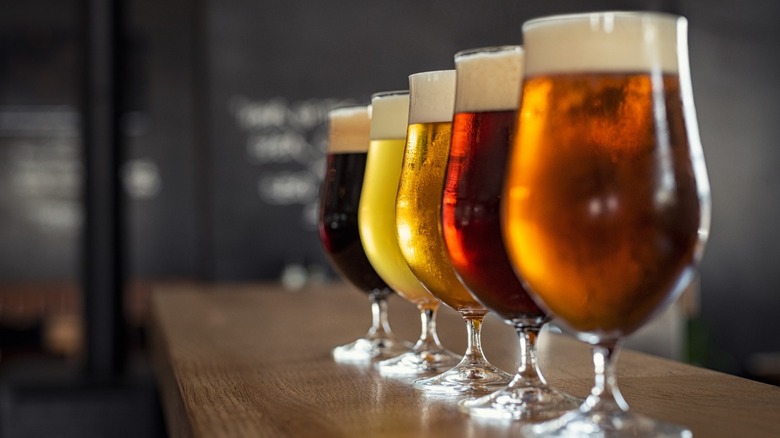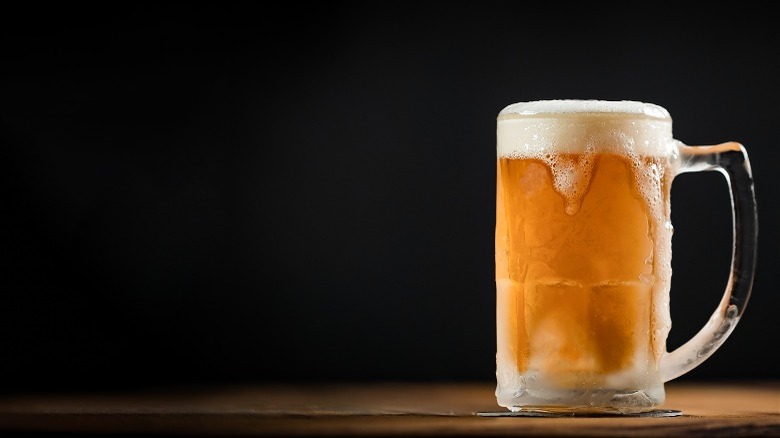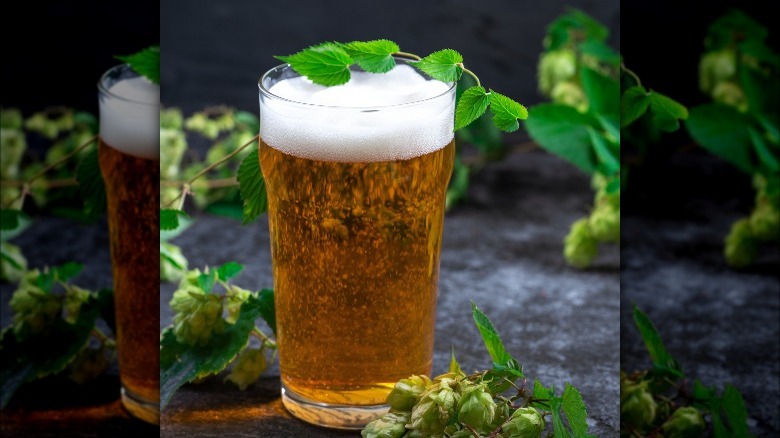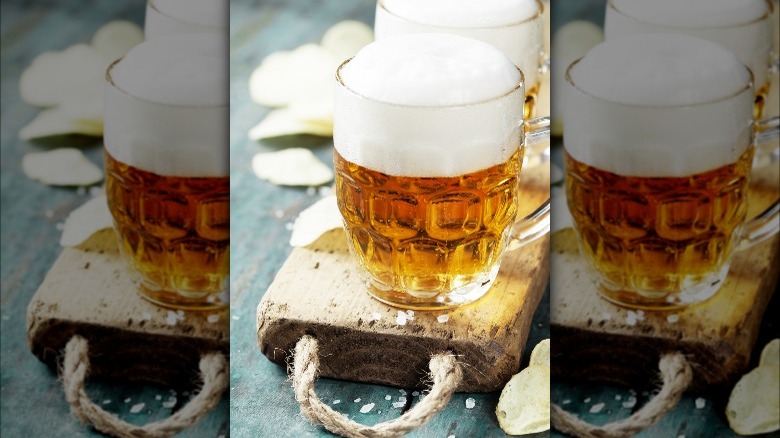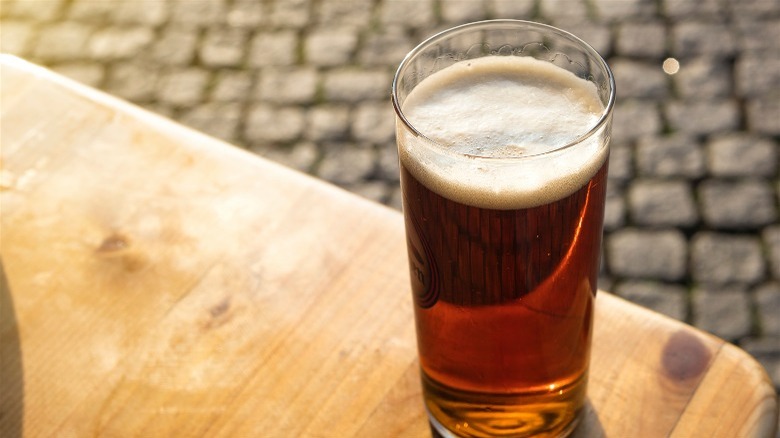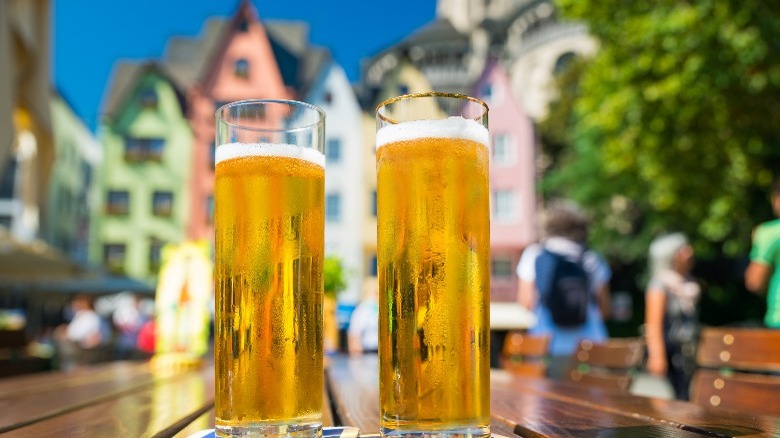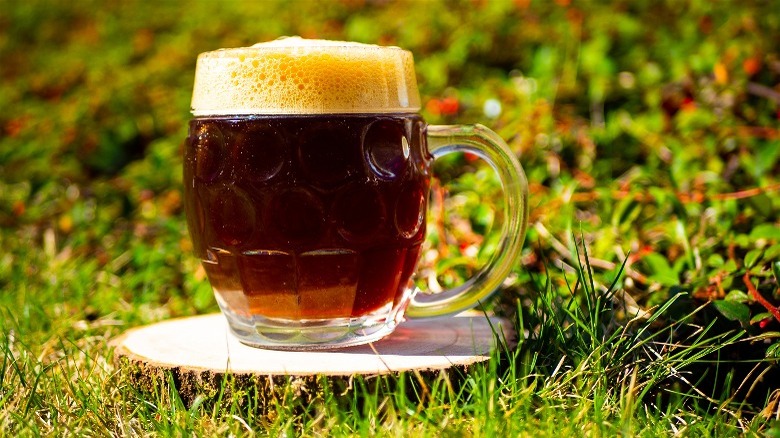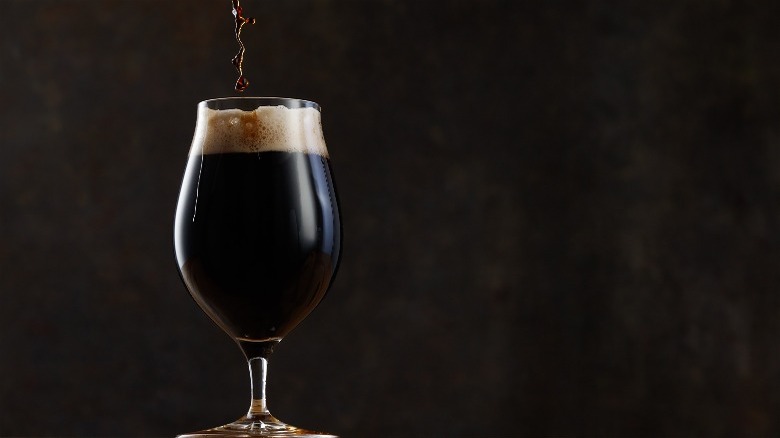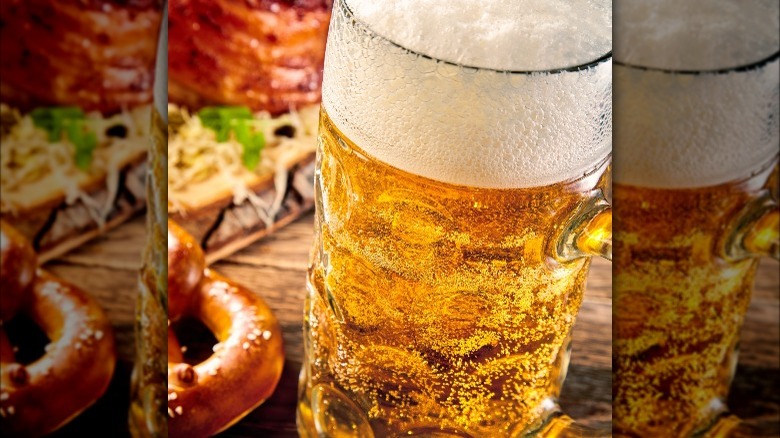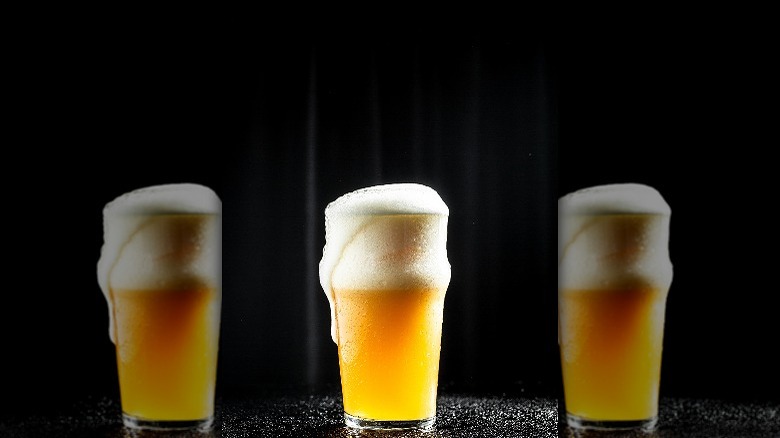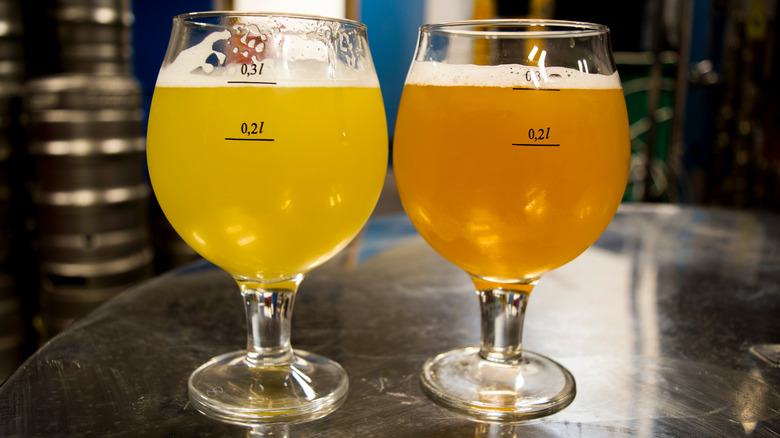10 German Beers To Try
Germany is the host of the world's largest festival dedicated to beer: Oktoberfest. So it's no surprise that Germans are wild about the drink. The festival's nearly 6 million yearly guests come to the southeastern city of Bavaria for that singular reason. Beer-making records date back more than 6,000 years, but in Germany, beer brewing didn't take off in popularity until the Middle Ages, according to German Culture. It wasn't until 1516 that German beer took on some semblance of what we know it to be today. A regulation, called the German Beer Purity Law, established production criteria for traditional German beer. It also clarified which ingredients were to be used: malted barley, hops, yeast, and water. When it comes to ales, the rules are more relaxed, and they can add wheat, hulled wheat, rye, and sugars.
Throughout its beer-loving history, Germany has developed a variety of types of beer. From light to strong, from bright to dark, German beer offers something for practically every flavor preference. So here are 10 German beers that are worth looking out for the next time you are strolling down the beer aisle.
Lager
The traditional method of German beermaking, which was put into law in 1516, actually only described one type of beer: lager. This style is one of the most traditional types of German beers, according to Anchor Brewing. Its name comes from the German verb lagern, which translates as "to store" (via Craft Beer & Brewing). Before industrialization, brewers had to make lager in the cold months of the year because, during summer months, the yeast activates too quickly and the beer develops other notes and aromas that would disagree with the purity law.
When it's colder, yeast ferments more slowly, per Brew Your Own. And lagers were often stored in cool basements for long stretches. The beer has a lot of varieties, resulting in slightly different profiles and alcohol levels. The taste is, in general, very full and refreshing, with a much rounder profile. Lager has a great balance of crispness, bitterness, and sweetness, which makes this type of beer popular all over the world. A great representative of this variety of beers is helles. This type of lager works great all year long, with or without food. Try the brands Tegernseer or Spaten if you come across them in a store or on a menu.
Pilsner
If you were asked to picture a typical beer, there's a strong chance you'd imagine a deep amber-colored drink topped with white foam. You might also assume it has a light and refreshing taste and a bitter finish. If that's what popped in your head, you may already be familiar with the style of beer called pilsner (pilsner is different from lager). Although originally from the city of Pilsen in the Czech Republic, according to Craftbeer.com, pils was created by a German beer brewer who was called to the city of Pilsen in the 19th century. At that time, beer companies were struggling to create a drink the public would enjoy. The styles were varied, with most tasting average at best. Once a new brewery was built, they called in an experienced brewer from Germany's Bavarian region, who tinkered with malts and hops.
Pils is generally a lighter beer, with refreshing and crisp notes that come from the different types of hops used. It is technically a lager but has such a huge reputation that it has developed into its own type of beer. Summer barley is preferred for pils because it packs more flavor and can counter the bitter notes from the hops better than barley harvested in winter. Pilsner is brewed all throughout Germany, and every producer will put their own spin on the taste and alcohol levels, but you can count on this being a refreshingly delicious sip. Great examples of German pils are Flensburger Pils, Radeberger, and Rothaus Pils.
Hefeweizen
Hefeweizen is the Bavarian style of beer, whose name translates to "yeast wheat," according to Allagash Brewing Co. As its name suggests, this beer is made with wheat and has two purposes: It creates a dryer profile and a creamier texture compared to other beers. The color is more amber-like, but you can also find filtered versions, which are called kristallweizen, that have a lighter color.
Bavarian wheat beer usually has at least 60% malted wheat, explains Storey.com. You'll notice this beer has bright, almost tangy flavors from the hops. Although it's a product of the southern part of the country, it is enjoyed all over Germany, especially during the summer months. In beer gardens, people mostly enjoy a Hefeweizen paired with a snack like some potato salad or a sausage. Hefeweizen is a type of weissbier and the two terms are sometimes used interchangeably. It dates back to medieval times but reached massive popularity in the 18th century when it was exclusively brewed by the Bavarian Royal Brewery, according to Brewvana. From there, its success story continued and love for the beer crossed all over Germany. Keep your eyes peeled for Paulaner, which is a tasty and typical example of this type of beer.
Altbier
To get a hint about the production of altbier, you just need to look at its name. Altbier, or "Oldbeer," comes from the region near Düsseldorf. The rather mild climate in this region made it impossible to brew lager-like beers, which need low temperatures. And brewers also could not make this like other ales, which need warmer temperatures for fermentation. And so producers depended on the original, so-called old ("alt") method of beermaking to wind up with their fermentation process, according to Beer and Brewing. Because of its production process, altbier is classified as an ale, but it has some specifics that set it apart.
This beer is fermented in cold temperatures, where the yeast activates slowly and the drink keeps its crispness and floral notes from the hops. It is pretty straightforward, with hints of sweeter and warmer notes. Craftbeer.com explains that altbier packs strong malty flavors paired with some peppery notes from the hops. Served ice cold, this beer is also a summer favorite. In the western city of Düsseldorf, a town in the region of Niederrhein, altbier is iconic. If you are looking for a stellar altbier, try Diebels.
Kölsch
Cologne is about 40 minutes south of Düsseldorf. Here, beer culture has shaped many of the city's traditions. But nothing has had more of an impact than kölsch. This is the beer of Cologne and historically it didn't receive its proper due because of how light it was. Today, however, the beer has grown in popularity, according to the Culture Trip. Kölsch is fermented with ale yeast but finished off in cold temperatures, which gives it a more lager-like flavor profile: crisp and dry with a fruity note. Production of kölsch was relatively relaxed until 1986 when a few brewers established a concrete definition for the beer: It had to be pale, top-fermented, hop-accented, and filtered, and those rules haven't changed since then, according to Renegade Brewing.
Kölsch is served in its very own 7-ounce highball glass. In Cologne's bars, according to Culture Trip, it's traditional for a server to replace your empty glasses with full ones unless you top your drink with a coaster. This could be a good thing, depending on your drinking speed. This is a perfect beer for anyone who prefers a light, refreshing drink. No need to worry about getting instant bloat off this beer. Gaffel has been brewing kölsch for more than 100 years and is a great option to get a feel for how it should taste.
Bock
In the Middle Ages, when beer brewing became a manual profession that spread all across Germany, one problem remained: Brewing beer during the summer was tough because it was too hot, according to Beerwulf. Without precise machinery, it was difficult to control the brewing and fermentation process. But since beer became such a popular beverage and trade good, brewers were determined to come up with a solution to this problem.
And the idea was simple yet effective: add more alcohol. Alcohol is a natural preservative and helps slow down the fermentation process while brewing. It prevents the yeast from developing unwanted aromas in the beer, one mistake you can make while brewing. This type of beer is called bock beer. Beerwulf says its origin seems to come from the city of Einbeck in Germany. The colloquial "ainpöckisch" became "Ein Bockbier" (a bock beer) over time. The color is dark and rich like an ale and it has a sweeter and fuller flavor, due to the higher alcohol content and the malted grain used. In addition, bock beer is stored longer than other beers, resulting in its signature bold flavor profile and smooth texture. If you're on the hunt for some bock options, try Göller or Karlsberg.
Dark (Dunkel)
In Germany, people say beer is like liquid bread. Beer can be filling and rich, which is evident in this next type: Dunkel. This beer is in the family of dark beer, which is generally a more filling kind of beer compared to other beers like lagers or ales. You might already be familiar with one of the most popular styles of dark beer, Irish stout like Guinness. While there are subtle differences, all share a similar recipe and profile.
The malt is roasted, giving the dark beers their rich, almost coffee-like color, explains Truly Experiences. Dunkel is popular for its deep color and full flavor profile. It packs hints of caramel and sweet bread, combined with a slightly bitter aftertaste, which makes it more popular during colder months of the year. Dunkel, like any dark beer, is also higher in calories and therefore makes you feel more full. The smooth and creamy texture ensures it is also a go-to easy drinking option and is definitely worth a try on your next bar crawl. Köstritzer is a well-known brewery that makes a must-try Dunkel beer.
Märzen (Oktoberfest)
Another popular German beer is Märzen, which is often served during Oktoberfest in Munich, where a massive amount of beer is consumed. This also became its second name: Oktoberfest beer, as it is known outside of Germany. This type of beer, which is technically in the lager family, was the first beer that was brewed in the colder months and stored in basements all summer. It was then consumed in late September and early October during Oktoberfest (via Food Republic). It is typically brewed with Munich malt, so named for the capital of Bavaria.
The color is deep gold and a big foam crown sits on top of it. The taste is described as full and sweet, and it's a good beer to have with Thanksgiving dinner. Marzen is on the lower end of the alcohol level scale, allowing you to enjoy one or several glasses (called Maß) at Oktoberfest. Lots of producers who make some kind of lager also make a Märzen for Oktoberfest. Visit Munich in October and see for yourself just how tasty it is.
Export
Export is another beer with a strong tie to one specific place in Germany. This beer was first brewed in the city of Dortmund, in the west of Germany, and is technically a lager. It was pilsner that inspired export beer, explains Black Tail NYC.
This beer is a bit higher in alcohol content and has a distinctive bitter taste to it. So it's pretty much a straightforward lager beer, but with a stronger flavor profile. Its color is golden and clear. The name comes from the fact that the brewers thought this beer was better than any other and should be exported so people all across the world would be able to enjoy and spread the word about top-class lager beers from Dortmund. Today, many producers make export beer, so you do not have to rely on the production of one city's brewers.
Berliner Weisse
Yet another beer with close ties to a city is Berliner Weisse. This beer, which is sometimes lovely referred to as the Champagne of the North, is a wheat-based beer originating from the region in and around Berlin. This type of beer was invented in the 17th century, making it one of the oldest styles of beer in Germany. But where almost every brewer made its own Berliner Weisse in the past, only a few remain today (via Hop Culture).
To be classified as a Berliner Weisse, this beer should have about 50% of wheat as its base grain. The other main ingredient is lactobacillus, an ambient bacteria that gives Berliner Weisse its specific acidity. This distinguishes this type of beer from other German beers and breaks with the traditional way of making beer there. It is the balance of tang and sweet that makes this beer perfect for the summer, and you may even consider Berliner Weisse to be more of a cider than beer. Although you can enjoy Berliner Weisse on its own, it is usually topped with some type of colored syrup, traditionally raspberry, complementing the sweetness and acidity.
